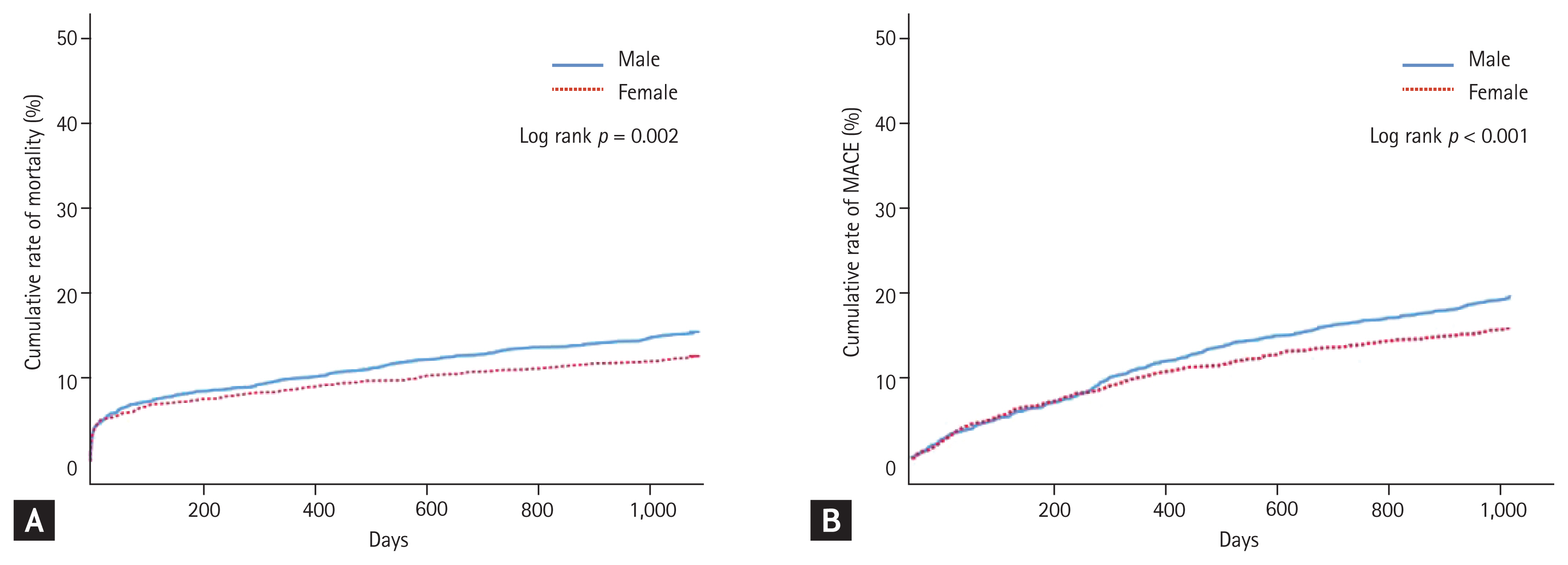1. Korea Centers for Disease Control. 2018 Disease Management White Paper. Cheongju (KR): KDCA, 2018.
2. Korea Centers for Disease Control. 2017 Disease Management White Paper. Cheongju (KR): KDCA, 2017.
3. Kannel WB, McGee DL. Diabetes and cardiovascular disease: the Framingham study. JAMA 1979;241:2035ŌĆō2038.


4. Yusuf S, Hawken S, Ounpuu S, et al. Effect of potentially modifiable risk factors associated with myocardial infarction in 52 countries (the INTERHEART study): case-control study. Lancet 2004;364:937ŌĆō952.


5. Wei CC, Shyu KG, Cheng JJ, Lo HM, Chiu CZ. Diabetes and adverse cardiovascular outcomes in patients with acute coronary syndrome: data from TaiwanŌĆÖs acute coronary syndrome full spectrum data registry. Acta Cardiol Sin 2016;32:31ŌĆō38.


7. Kim Y, Ahn Y, Cho MC, Kim CJ, Kim YJ, Jeong MH. Current status of acute myocardial infarction in Korea. Korean J Intern Med 2019;34:1ŌĆō10.


8. Centers for Disease Control and Prevention. National Diabetes Fact Sheet: National Estimates and General Information on Diabetes and Prediabetes in the United States. Atlanta (GA): CDC, 2011.
10. Vega G, Martinez S, Jimenez PA, Navarro A, Bernad F. Effect of cardiovascular risk factors on long-term morbidity and mortality following acute myocardial infarction. Rev Esp Cardiol 2007;60:703ŌĆō713.


11. Bensen JT, Li R, Hutchinson RG, Province MA, Tyroler HA. Family history of coronary heart disease and pre-clinical carotid artery atherosclerosis in African-Americans and whites: the ARIC study: atherosclerosis risk in communities. Genet Epidemiol 1999;16:165ŌĆō178.


12. Hu G, Jousilahti P, Qiao Q, Peltonen M, Katoh S, Tuomilehto J. The gender-specific impact of diabetes and myocardial infarction at baseline and during follow-up on mortality from all causes and coronary heart disease. J Am Coll Cardiol 2005;45:1413ŌĆō1418.


13. Juutilainen A, Kortelainen S, Lehto S, Ronnemaa T, Pyorala K, Laakso M. Gender difference in the impact of type 2 diabetes on coronary heart disease risk. Diabetes Care 2004;27:2898ŌĆō2904.


14. Melchior T, Kober L, Madsen CR, et al. Accelerating impact of diabetes mellitus on mortality in the years following an acute myocardial infarction. TRACE Study Group. Trandolapril Cardiac Evaluation. Eur Heart J 1999;20:973ŌĆō978.


15. Scanlon PJ, Faxon DP, Audet AM, et al. ACC/AHA guidelines for coronary angiography: a report of the American College of Cardiology/American Heart Association Task Force on practice guidelines (Committee on Coronary Angiography). Developed in collaboration with the Society for Cardiac Angiography and Interventions. J Am Coll Cardiol 1999;33:1756ŌĆō1824.


16. Ellis SG, Vandormael MG, Cowley MJ, et al. Coronary morphologic and clinical determinants of procedural outcome with angioplasty for multivessel coronary disease. Implications for patient selection. Multivessel Angioplasty Prognosis Study Group. Circulation 1990;82:1193ŌĆō1202.


17. Kini AS. Coronary angiography, lesion classification and severity assessment. Cardiol Clin 2006;24:153ŌĆō162.


18. Statistical Office. Cause of death statistics [Internet] Daejeon (KR): Statistical Office, 2018. [cited 2020 Dec 14]. Available from:
http://kosis.kr/statisticsList
.
19. Pyun WB. The differences of acute myocardial infarction in women in clinical characteristics and treatment. Korean Circ J 2007;37:49ŌĆō50.

20. Milner KA, Vaccarino V, Arnold AL, Funk M, Goldberg RJ. Gender and age differences in chief complaints of acute myocardial infarction (Worcester Heart Attack Study). Am J Cardiol 2004;93:606ŌĆō608.


21. Bonarjee VV, Rosengren A, Snapinn SM, James MK, Dickstein K. OPTIMAAL study group. Sex-based short- and long-term survival in patients following complicated myocardial infarction. Eur Heart J 2006;27:2177ŌĆō2183.


22. Kanic V, Vollrath M, Tapajner A, Sinkovic A. Sex-related 30-day and long-term mortality in acute myocardial infarction patients treated with percutaneous coronary intervention. J Womens Health (Larchmt) 2017;26:374ŌĆō379.


23. Korea Acute Myocardial Infarction Registry (KAMIR) Investigators. Lee KH, Jeong MH, et al. Gender differences of success rate of percutaneous coronary intervention and short term cardiac events in Korea Acute Myocardial Infarction Registry. Int J Cardiol 2008;130:227ŌĆō234.


24. Meisinger C, Heier M, von Scheidt W, Kirchberger I, Hormann A, Kuch B. Gender-specific short and long-term mortality in diabetic versus nondiabetic patients with incident acute myocardial infarction in the reperfusion era (the MONICA/KORA Myocardial Infarction Registry). Am J Cardiol 2010;106:1680ŌĆō1684.


25. Hu G, Jousilahti P, Qiao Q, Katoh S, Tuomilehto J. Sex differences in cardiovascular and total mortality among diabetic and non-diabetic individuals with or without history of myocardial infarction. Diabetologia 2005;48:856ŌĆō861.


28. Andreotti F, Marchese N. Women and coronary disease. Heart 2008;94:108ŌĆō116.


29. deFilippi CR, Tocchi M, Parmar RJ, et al. Cardiac troponin T in chest pain unit patients without ischemic electrocardiographic changes: angiographic correlates and long-term clinical outcomes. J Am Coll Cardiol 2000;35:1827ŌĆō1834.


30. Sim DS, Ahn Y, Jeong MH, et al. Clinical outcome of unprotected left main coronary artery disease in patients with acute myocardial infarction. Int Heart J 2013;54:185ŌĆō191.


31. Yamaguchi J, Kasanuki H, Ishii Y, et al. Serum creatinine on admission predicts long-term mortality in acute myocardial infarction patients undergoing successful primary angioplasty: data from the Heart Institute of Japan Acute Myocardial Infarction (HIJAMI) Registry. Circ J 2007;71:1354ŌĆō1359.


32. Ho KK, Anderson KM, Kannel WB, Grossman W, Levy D. Survival after the onset of congestive heart failure in Framingham Heart Study subjects. Circulation 1993;88:107ŌĆō115.


33. Halkin A, Singh M, Nikolsky E, et al. Prediction of mortality after primary percutaneous coronary intervention for acute myocardial infarction: the CADILLAC risk score. J Am Coll Cardiol 2005;45:1397ŌĆō1405.


34. Seol SY, Jeong MH, Lee SH, et al. Impact of gender differences in elderly patients with acute myocardial infarction. Korean J Med 2019;94:96ŌĆō106.








 PDF Links
PDF Links PubReader
PubReader ePub Link
ePub Link Full text via DOI
Full text via DOI Download Citation
Download Citation Print
Print



